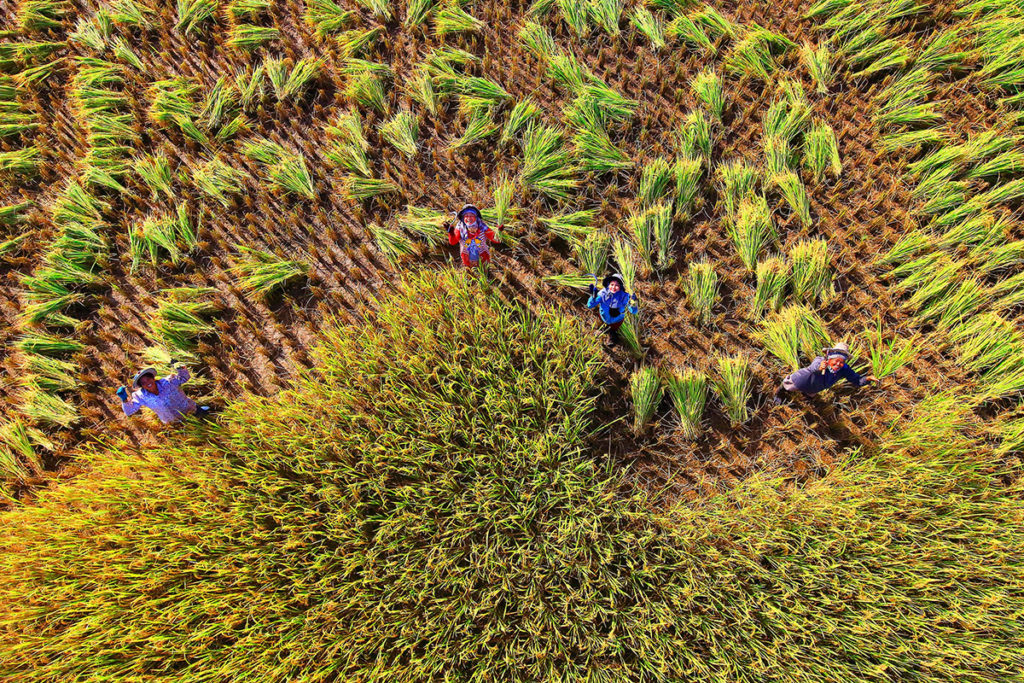I recently participated in a salon on integrating governance and food security work to enhance development outcomes. Convened by the LOCUS coalition and FHI 360, the salon gathered experts in evaluation, governance and food security to review challenges and best practices for generating evidence and knowledge. A post-salon discussion recorded with Annette Brown and Joseph Sany speaks to the gaps in evidence and the need to more accurately measure how governance principles influence food security outcomes.
I came out of the salon conversation thinking that while there was a hunger for evidence, there are still large gaps and significant differences within the literature on things as basic as definitions. That being said, I wanted to dig a bit more into what evidence was actually out there and think about what needs to be done to move this budding evidence base forward. In this post, I highlight three pieces of interesting research that contribute to the evidence base on governance and food security integration, and then propose a few suggestions on how to grow that knowledge base.
What evidence currently exists?
Numerous studies propose conceptual relationships between food security and governance, but there are a few rigorous pieces of evidence that demonstrate governance work has supported positive food security outcomes. I provide you with three examples here.
- Mercy Corps has an excellent report – Pathways from Peace to Resilience – that examines a natural resource management and peacebuilding program in the Mandera triangle of East Africa and a program including health and governance components in Uganda. Both programs build dispute resolution capacity and platforms with actors and institutions that are involved in conflict management within and between communities, and utilize both quantitative and qualitative methods. The study found that across study sites, strong conflict management capacities in institutions and communities contributed to greater food security for households that experienced shocks. This evaluation is excellent because it not only measures specific food security outcomes within a governance program (which is rare), but it also attempts to identify enabling factors between different programs that could facilitate the same kinds of outcomes in other governance programs.
- Another interesting report from the International Institute for Environment and Development showcases how farming is affected by governance and policy using case studies from Bolivia, Brazil, India, Kenya, Pakistan, Senegal, South Africa and Thailand. The case studies were undertaken to identify sustainable agricultural practices, and then to identify the policy and non-policy causes of those practices. The report argues that public policies had little involvement in many areas of success; instead local civil society and human capital proved the drivers of agricultural success in many places. In Senegal, for example, although the state has largely withdrawn from participating in local agriculture since liberalization in 1994, it has created enabling agricultural policy and legal environment for NGOs, producer organizations, and rural development institutions. This has allowed these organizations to fill the coordination and advocacy roles that the government does not provide and to support more beneficial policies for small-holder farmers.
Additionally, other case studies (in Bolivia, India and Pakistan) show that building social capital through NGOs or producer organizations, or through local decentralization of natural resources management, supports the power of communities to directly advocate for their rights and interests to achieve agricultural outcomes. Policies identified through these case studies that supported improved agricultural outcomes – like improving natural resource management, improving technology, improving market access – all were achieved by strengthening farmers’ bargaining power.
- Finally, a study on land tenure and food security provides a framework to understand the link between governance and food security. Maxwell and Wiebe present the links between land and food as a linear relationship of resources, production, income, consumption and nutrition status. Using this as a jumping off point, they examine the land tenure literature. Among other topics, the authors present multiple sources showing a quantitative link between access to food and access to land in an agrarian economy. Using a study from Thailand, the authors show that increased tenure security leads to increased demand for land improvements from farmers and increased formal credit supply because farmers have access to collateral (land). Both effects resulted in short- and long-term investment in agriculture and production.
There are also ripple effects to bad policymaking that can be felt when households experience shocks. A study in Ethiopia documents that during food crises, insecure land tenure causes people to delay moving in search of food assistance. This reluctance may have increased the death toll in Ethiopia during the 1984-1985 famine. Maxwell and Wiebe utilize this and other evidence to propose a more circular, dynamic relationship between food security and land tenure, and offer suggestions for researchers and policymakers given the dynamic relationship. This paper is valuable as it serves as a literature overview for land tenure and food security, as well as detailing conceptual relationships that can be tested and measured.
There is not enough evidence to come to any kind of conclusion on what works and, further, there does not appear to be a cohesive direction for growing evidence and knowledge. Recognizing different research cultures, different definitions for food security and governance, and the limited number of existing studies, I find it difficult to envision how this evidence base will move forward.
However, in a world where conflict is becoming more common, and governance and food security are inextricably tied up in the resilience of communities to survive both human and climatic shocks, I think we need to understand the relationship better, and understand how integrating programs can better improve outcomes in both sectors.
How do we grow the evidence base?
Considering how other multi-sector groups have built a knowledge base in their respective areas, I propose a few first steps to expand the evidence base for governance and food security.
- Clarify common terms and theoretical framing.
As noted in the transdisciplinary toolkit for integration methods and FHI 360’s resource package for integrated development, agreeing on common terms and theoretical frameworks is one of the first steps to conducting research that is useful across disciplines. In the case of governance and food security, multiple evidence reviews have noted the diverse concepts and frameworks used throughout the literature. Narrowing that field could go a long way to directing future research.
- Establish what level of evidence is necessary.
Much of the evidence around governance and food security is conceptual, rather than empirical. The existing empirical evidence largely lacks the rigor present within other sectors. But is that level of rigor needed or possible in this space? If there is a consensus on what is needed, then it will be easier for the community to plan for what is necessary and move the conversation forward.
- Develop a targeted research agenda.
Big questions were asked during the LOCUS salon including, “When is governance a necessary condition, and when is it a sufficient condition?” and “What motivates farmers to get involved and engaged in local governance?” Developing key questions can focus researchers in different locations on the same topics to generate enough evidence in targeted areas to produce broader findings.
- Improve formative research.
Improving formative research can provide a short-term win with long-term benefits. Using multi-criteria assessment, root-cause analysis, and other methods to assess food security or governance from a multi-sector perspective from the beginning will affect what outcomes are reported. By being more deliberative about what we are measuring early in the project, we can use the data from projects to better illustrate where governance is contributing to development outcomes and evaluate that more rigorously in the future.
- Explore non-traditional evaluation methods.
Using alternative evaluation methods can also help us better understand how food security and governance are related, and where investing in governance for food security is more necessary. Methods like contribution analysis or complexity-aware monitoring can provide results that are not available through more traditional means.
- Form integrated teams and procedures.
Engaging multi-sector stakeholders, ensuring a place for multi-sector perspectives on a team, and inserting decision points to ask about integration have been successful in other multi-sector spaces (documented here in a nutrition-sensitive agriculture program). Ensuring that there is space for those kinds of discussions could ensure that other perspectives are included in the evaluation process.
These steps can close the gaps and expand the evidence base for governance and food security. What do others think is necessary? How can we continue to move this conversation forward? What other evidence in governance and food security do you find compelling?
Photo caption: Northern Thai farmers work under the Royal Initiative Project, which promotes alternative crops in Thailand as a means to generate income.
Photo credit: © 2016 Hansa Tangmanpoowadol, Courtesy of Photoshare



